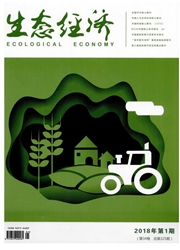

 中文摘要:
中文摘要:
能源足迹是分析区域经济发展与资源环境关系的重要评价指标和方法。中国能源足迹动态变化及影响因素分析,可为社会经济-资源环境可持续发展提供理论基础。以中国能源消耗统计数据及全国森林资源清查数据为基础,利用能源足迹计算方法和STIRPAT模型,分析了1978~2013年中国能源足迹动态变化和影响因素,结果表明:(1)中国能源足迹呈增加趋势,主要集中在经济和能源消耗量快速增加的2002~2013年。中国能源足迹赤字水平逐步扩大,能源足迹生态压力增大,生态环境安全水平较低,生态风险较高,需引起重视。(2)中国能源足迹构成变动较小,能源足迹构成仍以EEF(煤品)为主,EEF(油品)次之,EEF(天然气)最小,表明中国能源消耗结构调整任重而道远。(3)1978~2013年中国人均GDP和能源足迹产值均呈指数增加趋势,而能源足迹强度呈指数减少趋势。(4)能源足迹与人均GDP、第二产业占GDP比重和单位工业增加值能耗呈正相关关系,与人口数量呈负相关关系。所有影响因素中,人均GDP对能源足迹的解释程度最高,单位工业增加值能耗和第二产业占GDP比重次之,人口数量最低。
 英文摘要:
英文摘要:
Energy ecological footprint (EEF) is an important evaluation indicator and method to analyze the relationship between regional economic development and resources - environment. Dynamic change analysis of EEF and its influencing factors, would provide a theoretical basis for sustainable development of social-economic and resources- environment. Dynamic change analysis of EEF and its influencing factors in China from 1978 to 2013, is carried out on the basis of energy consumption data and forest inventory data, using EEF calculated method and STIRPAT model. The results showed: (1) EEF in China showed an increasing trend, which mainly in the period of 2002-2013 with rapid development of economic and energy consumption. EEF deficit in China expanded gradually, which reflect increasing pressure on EEF, low security of ecological environment and a higher ecological risk. We need to pay more attention. (2) Construction of EEF in China had a small change, and the construction of EEF is still mainly EEF (coal and coal product), EEF (oil and oil product) followed, and EEF (natural gas) minimum, which reflect that it would be a long way to go in the structure adjustment of energy consumption. (3) Per capita GDP and EEF output in China from 1978 to 2013, showed an increasing trend exponentially, while EEF intensity showed a decreasing trend exponentially. (4) EEF had positive correlation with per capita GDP and the proportion of secondary industry in GDP, while had negative correlation with population. Per capita GDP had the highest explanatory degree to EEF, energy consumption of per unit of industrial added value and the proportion of secondary industry in GDP followed, while the population was the lowest.
 同期刊论文项目
同期刊论文项目
 同项目期刊论文
同项目期刊论文
 期刊信息
期刊信息
